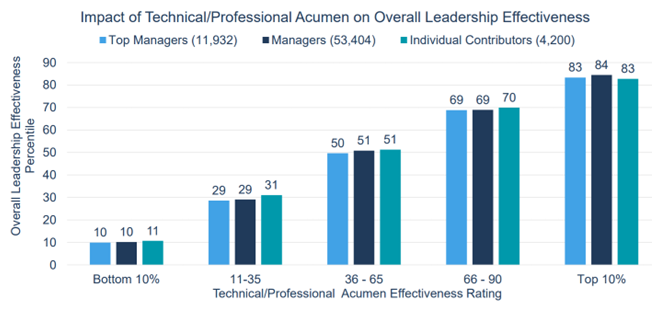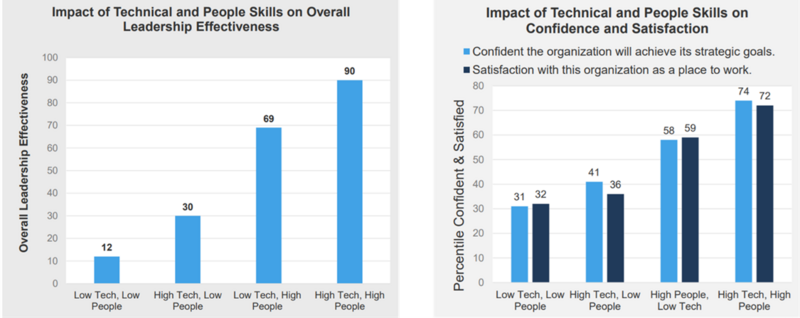ATD Blog
Using Two Oars to Row Into Extraordinary Leadership
Wed Apr 19 2023

Fifty years ago, it was believed that effective general managers needed to be good at management but did not need to understand the business’s technical aspects. Half a century later, the myth prevails that managers don’t need deep technical acumen to lead today’s complex organizations. However, research shows that the most effective general managers are highly knowledgeable about the business’s technology. The leadership competency “technical and professional acumen” is the functional ability to do your work and is defined as “demonstrates and shares exceptional expertise and job knowledge and is trusted as a significant contributor to team results.”
And yet, that technical or functional expertise is not enough. So, what’s missing? Jack Zenger and Joe Folkman—co-founders of Zenger Folkman, best-selling authors, and world-renowned leadership experts—recently answered that question for members of the ATD Forum. They likened leaders who possess only technical acumen to rowing a boat with just one oar—it’s difficult and leaves you in circles. Next, they identified the second oar and how it enhances technical acumen and supports extraordinary leadership. Finally, they invited participants to take the Technical Preference Self-Assessment and create their development plan to build out “the second oar.”
The First Oar
Technical acumen is important at all levels of leadership (see Figure 1). Zenger and Folkman have unveiled a new competency in digital expertise, defined as someone who adopts technological and digital developments that can create a competitive advantage for the organization. There’s a striking difference in overall leadership effectiveness between those rated in the bottom 10 percent of technical and professional acumen effectiveness and those rated in the top 10 percent. With organizations becoming more complex and technology increasing exponentially, the best leaders must increase their technical acumen throughout their careers.
Figure 1: Technical Acumen Is Important at All Levels

In spite of this, research conducted at Bell Labs found that knowledge and intelligence were not sufficient to create star performers. Instead, the best performers combined knowledge and intelligence with other skills. This magnified their effectiveness and enabled them to deliver outstanding results.
The Second Oar
If technical acumen is the first oar, what’s the second oar? It turns out that two different sets of characteristics have emerged to co-create the second oar.
The first is drives for results. Zenger and Folkman discovered the following:
If technical and professional acumen is a strength, but _drives for result_s isn’t, the probability of being an extraordinary leader is 8 percent.
If technical and professional acumen is NOT a strength, but **drives for result**s is, the probability of being an extraordinary leader is 12 percent.
If BOTH technical and professional acumen AND **drives for result**s are strengths, the probability of being an extraordinary leader is NOT 8% + 12% = 20%, but 78 percent!
As you can see, neither technical and professional acumen alone (the first oar), nor drives for results alone (the second oar), is sufficient to make one an extraordinary leader. But the powerful combination of the two produces amazing results.
The other set of characteristics that co-creates the second oar is Soft (People) Skills. These include being a good coach; communicating and listening well; having empathy toward and being supportive of colleagues; and creating a space for every team member to speak up, make mistakes, and know they’re being heard. As Figure 2 indicates, the difference in overall leadership effectiveness between low-tech/low-people-skill leaders and high-tech/high-people-skill leaders is striking. In addition, employee confidence (that the organization will achieve its strategic goals) and satisfaction (with the organization as a workplace) are significantly lower when leaders demonstrate low-tech/low-people skills and significantly higher when leaders demonstrate high-tech/high-people skills.
Figure 2: Impact of IQ and EQ on Overall Leadership Effectiveness and Impact of Technical and People Skills on Confidence and Satisfaction

Six Catalysts
So, how does one increase technical and professional acumen? One mode of development is linear and includes engaging in activities like reading and keeping up to date in one’s field:
Studying
Taking courses
Working with mentors and coaches
Participating in after-action reviews
The other mode of development is nonlinear. It requires understanding which behaviors enable—even magnify—the effectiveness of leaders with adequate levels of technical and professional acumen.
According to Folkman and Zenger, six catalysts, or acumen-boosting behaviors, emerged from this work and co-created the second oar. These include the ability to:
Solve problems. Putting acumen to use by applying it to immediate problems unleashes the value of technical competence.
Build relationships. Only when a person develops strong interpersonal relationships is the full extent of their technical and professional skills seen and utilized by others. Positive relationships lead to the acquisition of new knowledge and information.
Communicate powerfully. Having the ability to convey their expertise clearly sets apart highly effective leaders from average leaders.
Develop a broad perspective (the what – why – how). Those with a narrow perspective have difficulty making connections outside their specific expertise area. Their knowledge and expertise will be perceived as limited and narrow. A broad perspective—knowing what to do, why they’re doing it, and how to do it—magnifies the number and size of problems that technical expertise can help solve.
Take initiative. Having expertise and seeking opportunities to apply that knowledge, especially outside of one’s work area, is a way for others to see one’s expertise in action.
Act in the team’s best interest. Those who consistently put the team’s best interests first are perceived to be more trustworthy. This trust often is extended to include their technical and professional expertise. Others trust that their decisions are based on expertise, facts, and data—not biases or ulterior motives.
Call to Action
Where do you fall with your desire to acquire and demonstrate technical expertise? How well-developed are your six catalysts? And how effective are you with your technical and professional acumen and expertise? Do you have a fatal flaw in any of the strength-building behaviors? Would improving that behavior have a positive impact on my performance in my current job? What about the catalysts? Which one should you upskill first?
To be the most effective leaders possible, we must understand our level of technical and professional acumen and enhance that by driving for results and developing or leveraging the six catalyst behaviors. Zenger and Folkman have been building extraordinary leaders for decades; use these tools to develop both oars and row your boat toward great success.
